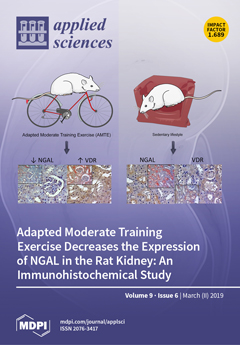Hydrodeoxygenation (HDO) of bio-oil is a method of bio-oil upgrading. In this paper, x%CeO
2–Ni–Cu/HZSM-5 (x = 5, 15, and 20) was synthesized as an HDO catalyst by the co-impregnation method. The HDO performances of x%CeO
2–Ni–Cu/HZSM-5 (x = 5, 15,
[...] Read more.
Hydrodeoxygenation (HDO) of bio-oil is a method of bio-oil upgrading. In this paper, x%CeO
2–Ni–Cu/HZSM-5 (x = 5, 15, and 20) was synthesized as an HDO catalyst by the co-impregnation method. The HDO performances of x%CeO
2–Ni–Cu/HZSM-5 (x = 5, 15, and 20) in the reaction process was evaluated and compared with Ni–Cu/HZSM-5 by the property and the yield of upgrading oil. The difference of the chemical composition between bio-oil and upgrading oil was evaluated by GC-MS. The results showed that the addition of CeO
2 decreased the water and oxygen contents of upgrading oil, increased the high heating value, reduced acid content, and increased hydrocarbon content. When the CeO
2 addition was 15%, the yield of upgrading reached the maximum, from 33.9 wt% (Ni–Cu/HZSM-5) to 47.6 wt% (15%CeO
2–Ni–Cu/HZSM-5). The catalytic activities of x%CeO
2–Ni–Cu/HZSM-5 (x = 5, 15, and 20) and Ni–Cu/HZSM-5 were characterized by XRD, N
2 adsorption–desorption, NH
3-Temperature-Programmed Desorption, H
2-Temperature-Programmed Reaction, TEM, and XPS. The results showed that the addition of CeO
2 increased the dispersion of active metal Ni, reduced the bond between the active metal and the catalyst support, increased the ratio of Bronsted acid to total acids, and decreased the reduction temperature of NiO. When the CeO
2 addition was 15%, the activity of catalyst reached the best. Finally, the carbon deposition resistance of deactivated catalysts was investigated by a Thermogravimetric (TG) analysis, and the results showed that the addition of CeO
2 could improve the carbon deposition resistance of catalysts. When the CeO
2 addition was 15%, the coke deposition decreased from 41 wt% (Ni–Cu/HZSM-5) to 14 wt% (15%CeO
2–Ni–Cu/HZSM-5).
Full article





